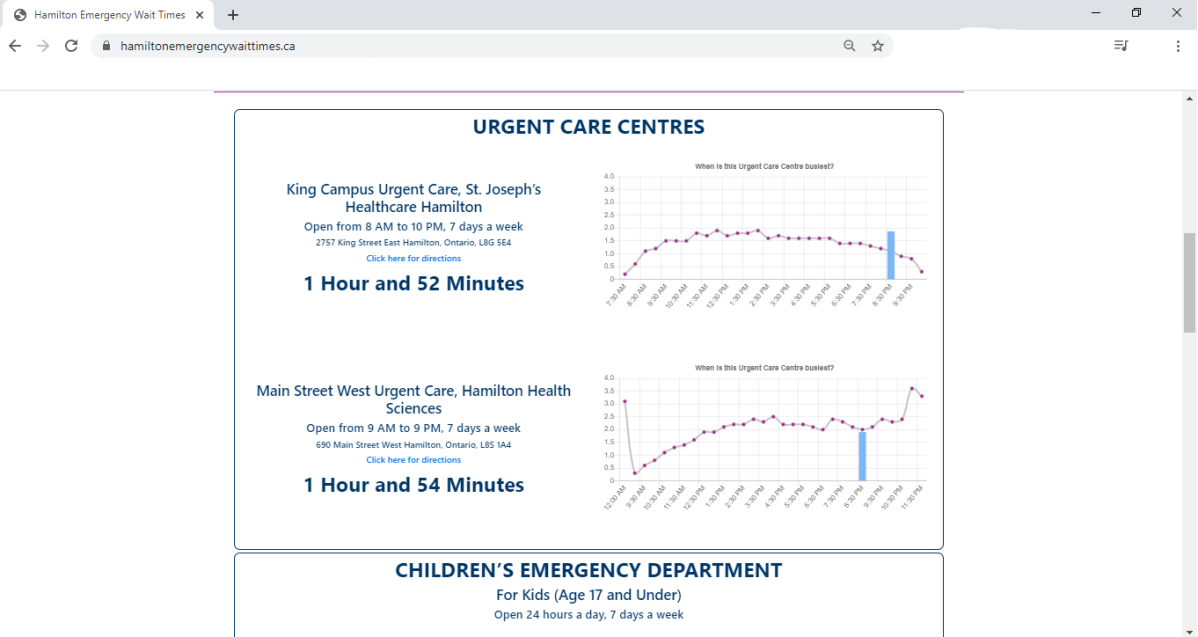Hamilton Health Sciences and St. Joseph’s Health Care has launched a new website providing real-time views of wait times for emergency departments and urgent care centers in the surrounding area.

The site — hamiltonemergencywaittimes.ca — became active on Wednesday, allowing residents in Hamilton and the surrounding area to access wait times for two urgent care centres, four adult emergency departments and McMaster Children’s Hospital.
Patients will now be able to get the average length of time it will take to see a doctor or nurse from the time of registration to triage.
Wait times are determined on the previous six-hour period and will be automatically updated every 15 minutes, according to a joint release from St. Joseph’s and Hamilton Health Sciences.
At its core are online graphs that show a history of the hospital’s volumes throughout the day and a current clock showing how long it would be to see a physician at the emergency departments.
Dr. Greg Rutledge, St. Joe’s chief of emergency medicine, says people will be able to match the information to their individual needs.
He told Global News that It will be especially useful for patients with less serious conditions who can use it to choose when and where to seek care.
“There are still gonna be people who have services like nephrology, or their heart doctors, or their lung doctors, who should go regardless of the wait time,” said Rutledge.
“But for those that have less serious conditions, they can decide not only where but when to go.”
Rutledge says the change comes after the facilities realized patients wanted more “active involvement” in their care through technology.
“Nowadays we have a medical electronic record, so It’s easy to pull that data through,” Rutledge said. “It’s all automated across the two sites so it can just roll continually or every 15 minutes.”
However, he says the tool is really for those who need treatment for non-critical ailments and can take time to travel to a more distant location with a shorter wait time. He urges patients with more severe conditions to attend the closest hospital as soon as possible.
“One of the things we worry about is patients making decisions about their care purely based on the time that it will take to get seen,” said Rutledge.
“Because the worst thing that could happen here is someone goes on there and says, ‘oh, it’s three hours to see a doc. I’m having chest pain, but I’m going to wait,’ when they should not be waiting to see a physician.”

Rutledge say patients with urgent conditions get priority at an emergency unit and are always bumped to the front of the line.
A number of other nearby Ontario communities already have wait-time clocks including the Niagara Health Region and St. Mary’s General Hospital in Kitchener, who’s had a system in place for seven years.
Gary Higgs, VP and Chief Information Officer at St. Mary’s says it’s been a useful tool to help manage flow through our it’s urgent care departments.
He says patients and families “value” the clock because it allows them to have an idea of what to expect and plan for long wait time, bringing things like books and snacks for the children while arranging care.
“The clock is for expectation setting, patient education, improving the patient experience and providing contact information for alternatives to the emergency department for people who recognize that their issue may not require an emergency department visit,” said Higgs.
Higgs says pageviews on the wait-time clock continue to rise year over year. In the winter of 2013, a year after the clock was implemented, pageviews averaged around 4,000 per month.
In 2017, that number had grown to an average of 8,000 per month before moving to 9,000 per month in the winter of 2019.
Higgs goes on to say the system does not seem to deter potential patients with non-urgent health issues, as he says the hospital has actually seen an increase in emergency visits in recent years.
“In the past few years we have seen an overall increase in visits to the emergency department, so it is more difficult to determine if the clock is effective in reducing waits,” said Higgs.
“Certainly patients and families say they appreciate knowing what to expect in terms of the wait so they can make decisions and plan, and that is the ultimate goal of the clock.”





Comments